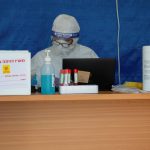Study Reveals How Plasmids Evade Bacterial Defenses, Offering Hope for Antibiotic Resistance Solutions
Jerusalem, 30 December, 2024 (TPS-IL) -- An Israeli study released on Monday revealing how foreign DNA can evade bacterial defense systems and neutralize them opens a door to combating antibiotic resistance and the development of more precise genetic engineering techniques for medical, environmental and industrial purposes.
The Tel Aviv University study, led by PhD student Bruria Samuel from Prof. David Burstein’s lab at the Shmunis School of Biomedicine and Cancer Research, identifies a strategic mechanism that allows plasmids—small, mobile DNA molecules—to bypass bacterial defenses. The findings were published in the peer-reviewed journal Nature.
Genetic diversity is essential for the survival of species, allowing adaptation to environmental changes. While humans rely on sexual reproduction for genetic variation, bacteria achieve it through mechanisms such as conjugation — a process where one bacterium transfers DNA to another via a microscopic tube.
Plasmids, small circular DNA fragments classified as “mobile genetic elements,” are central to this process. Unlike viruses, plasmids transfer between bacteria without harming their hosts, often providing genetic advantages, such as antibiotic resistance.
However, bacteria possess defense mechanisms designed to destroy foreign DNA.
“Conjugation is a well-known process used in labs to transfer genes between bacteria,” Burstein explained. “While scientists have long known that plasmids face bacterial defenses, how they overcome these barriers has remained a mystery.”
Samuel began by analyzing a database of 33,000 plasmids, identifying genes associated with “anti-defense” systems that enable plasmids to evade bacterial defenses. Notably, these genes are strategically located near the DNA entry point on plasmids. This positioning ensures that they are the first to be activated upon transfer into a recipient cell, giving plasmids an immediate advantage.
“This strategic arrangement allows the plasmid to neutralize the recipient bacteria’s defenses as soon as it enters,” Samuel said. “It’s a phenomenon that had not been identified before, despite extensive research into plasmids and bacterial defenses.”
Burstein initially found it hard to believe that such a phenomenon had gone unnoticed. “Bruria conducted an exhaustive literature review and confirmed that this connection was previously unknown,” he said.
To validate their findings, the team conducted experiments using plasmids carrying antibiotic resistance genes. These plasmids were introduced into bacteria equipped with CRISPR systems designed to target and destroy plasmid DNA. CRISPR systems are a type of molecular tool used by bacteria to protect themselves from viruses. They work by recognizing and cutting viral DNA. Scientists have harnessed this natural defense mechanism to edit genes in other organisms, including humans.
The results were compelling. The researchers found that plasmids with anti-defense genes near the entry point overcame CRISPR defenses, allowing the recipient bacteria to survive and gain resistance. When these genes were positioned elsewhere, the plasmids were destroyed, and the bacteria died upon antibiotic exposure.
“This demonstrated the critical role of gene positioning in plasmid success,” Samuel explained.
The study’s findings could revolutionize genetic engineering. Understanding anti-defense systems may lead to the identification of new genes for use in synthetic biology and genetic manipulation. For example, researchers could design more efficient plasmids for laboratory and industrial purposes, such as breaking down pollutants, fixing carbon dioxide, or modifying gut bacteria to improve human health.
Additionally, this knowledge could help combat antibiotic resistance. By developing plasmids capable of blocking resistance genes in hospital bacterial populations, researchers might slow the spread of resistant strains.
“Our study also offers insights for improving plasmid-based genetic transfer,” Prof. Burstein noted. “While natural plasmids are highly efficient, those used in labs often lag behind. Enhancing this process could unlock new possibilities for research and industry.”
Dr. Ronen Kreizman, CEO of Ramot, Tel Aviv University’s technology transfer company, said he is now working to commercialize the technology.
“This research opens revolutionary possibilities in fields like drug development, synthetic biology, agritech, and foodtech,” said Kreizman. “The ability to control genetic material transfer between bacteria could address critical challenges in healthcare, agriculture, and environmental sustainability.”







